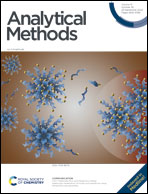Highly sensitive surface acoustic wave biosensor for the detection of Hg2+ based on the thymine–Hg2+–thymine structure†
Abstract
The detection of mercury ions (Hg2+) with an ultralow concentration is of great significance for the treatment of heavy metal pollution in industrial waste water and the monitoring of drinking water quality. In this study, a simple, sensitive, and portable surface acoustic wave (SAW) biosensor for the determination of Hg2+ concentration was developed. First, a DNA fragment with a specific binding capacity for Hg2+ was chemically adsorbed on to the sensitive region through forming Au–S bonds with the SAW biosensor. The DNA probe could then form a thymine–Hg2+–thymine (T–Hg2+–T) complex with strong affinity for Hg2+ after immersion in a test solution containing Hg2+, resulting in a significant change in the response frequency of the device. The linear detection range of the device was 10 pM to 1 nM, while the limit of detection (LOD) was as low as 6.3 pM. Furthermore, the SAW biosensor exhibited excellent selectivity to Hg2+ compared with that of interfering ions, e.g., Ag+, Ba2+, Cu2+, Zn2+, Mn2+, Fe3+, Ca2+, and Na+. The results provide a new strategy for the preparation of portable devices that can monitor toxic heavy metal ions with high sensitivity and selectivity.



 Please wait while we load your content...
Please wait while we load your content...